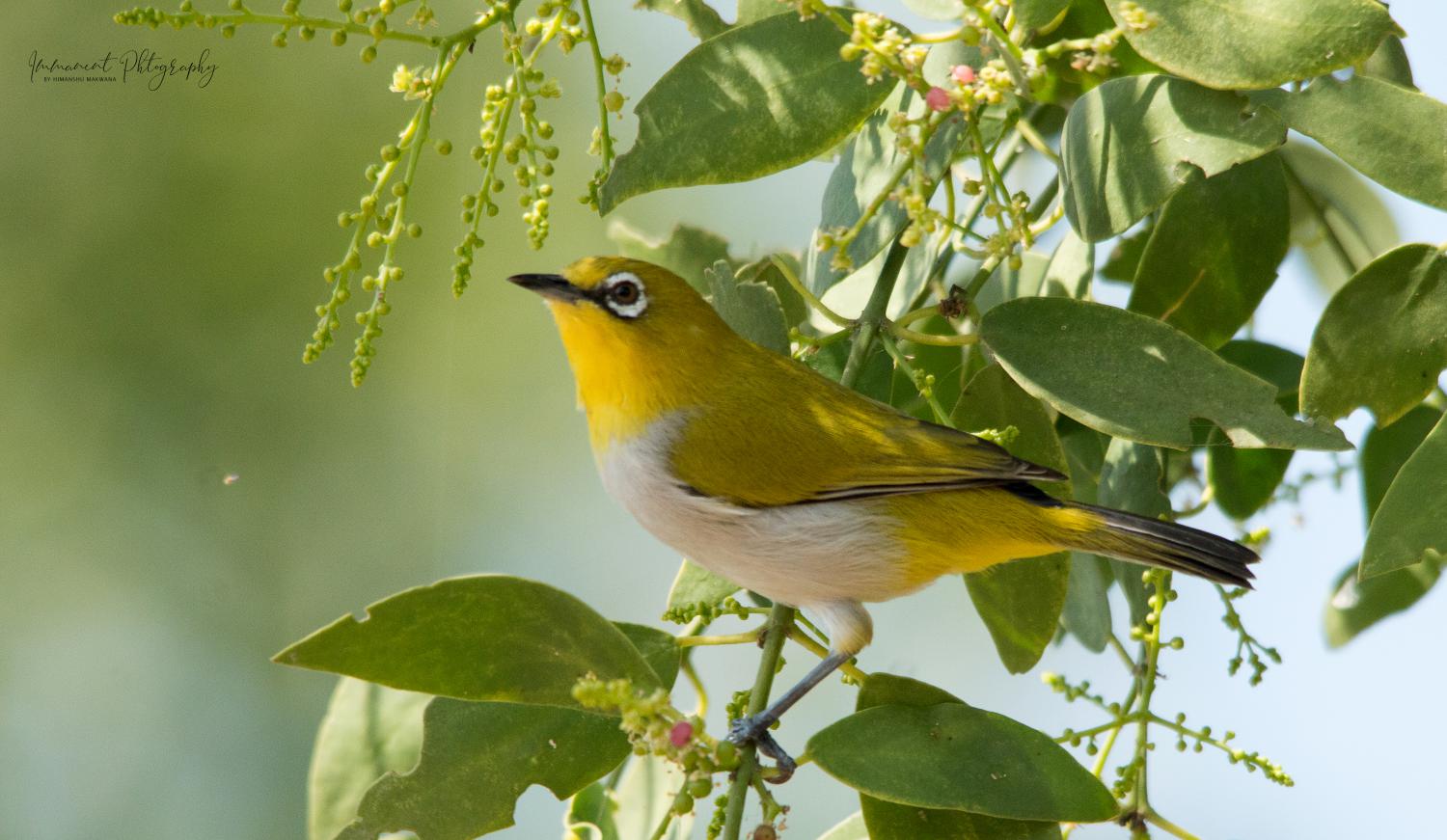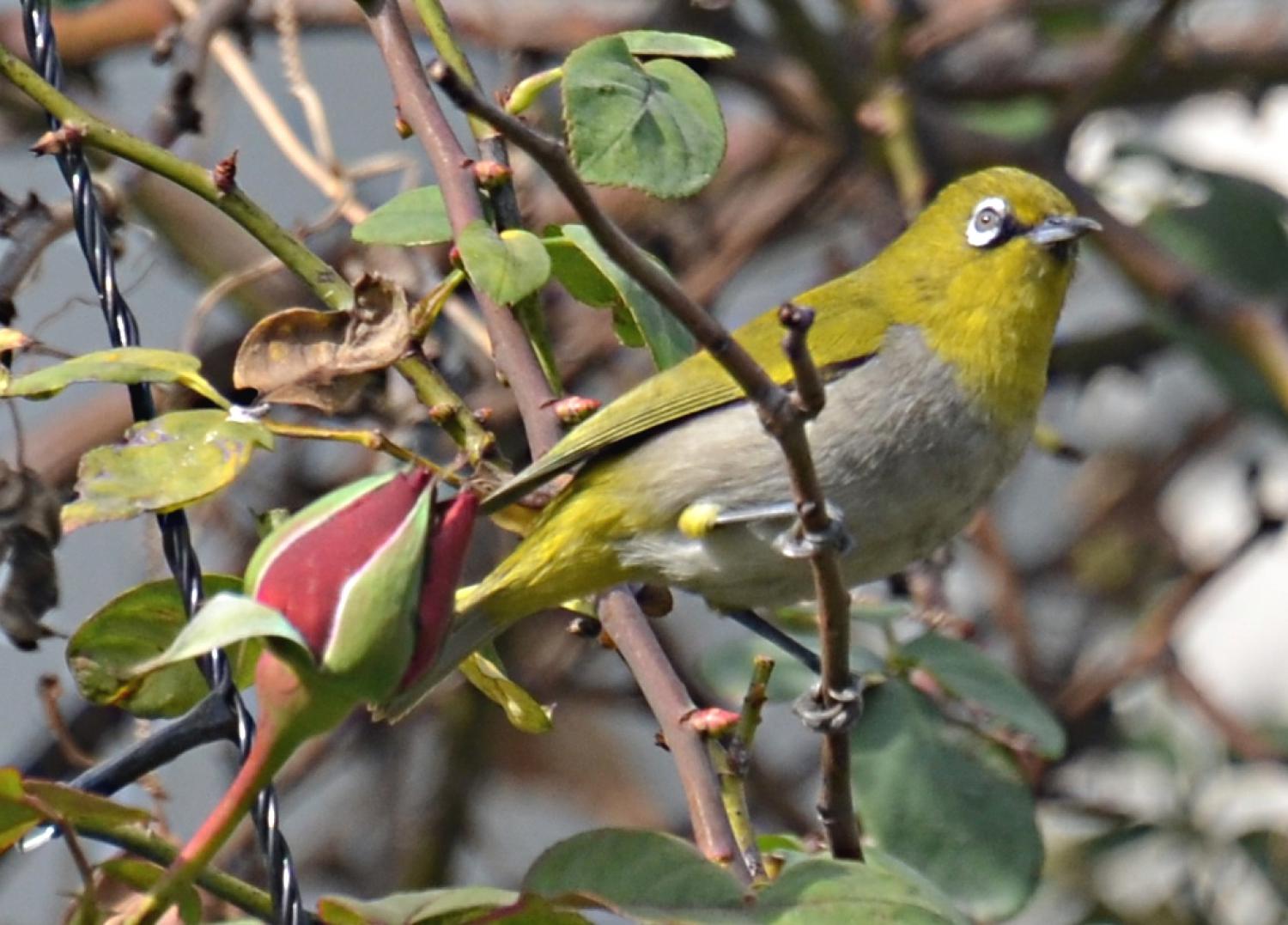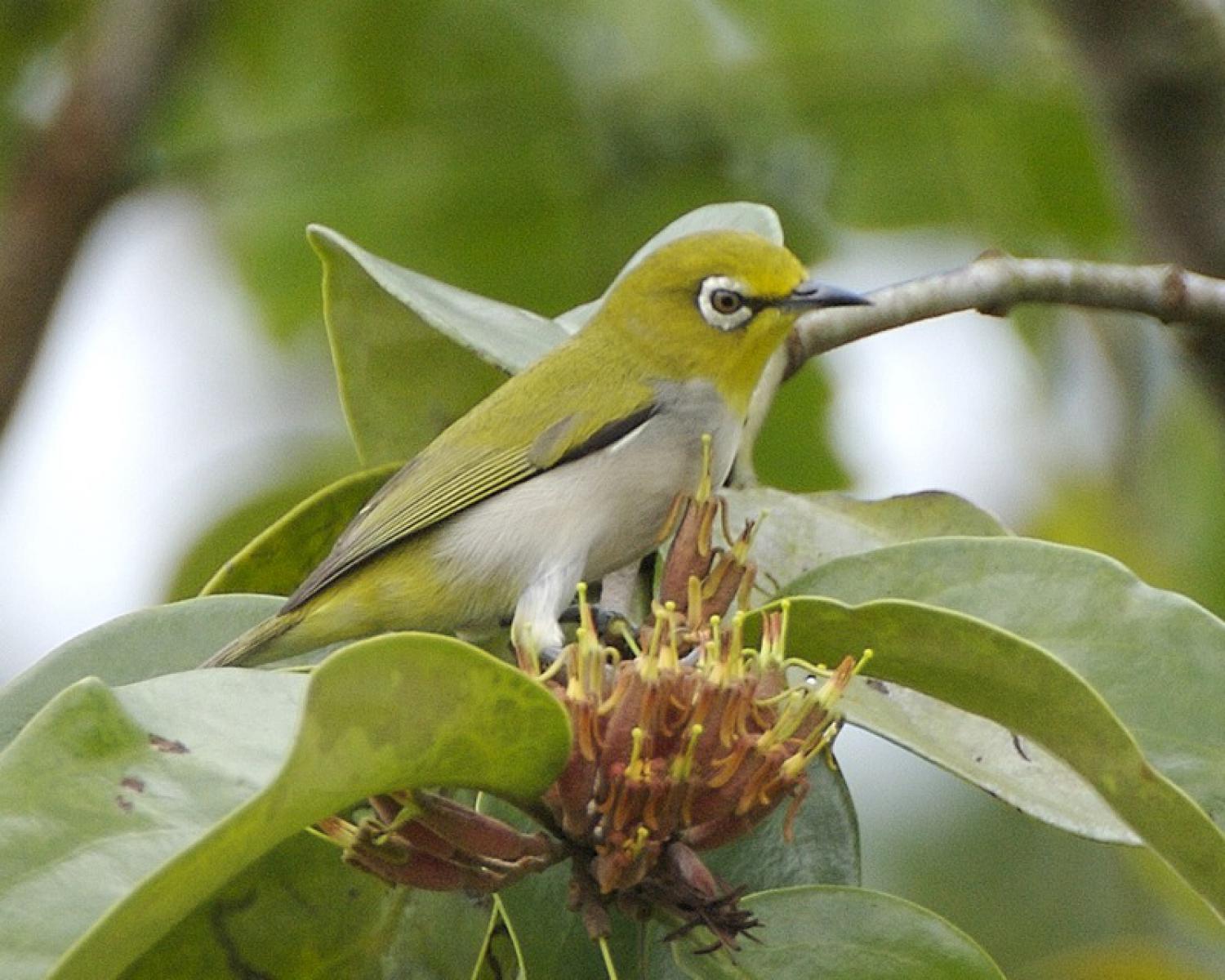Species of Thailand
Indian white-eye
Zosterops palpebrosus
Coenraad Jacob Temminck, 1824
In Thai: นกแว่นตาขาวสีทอง
The Indian white-eye (Zosterops palpebrosus), formerly the Oriental white-eye, is a small passerine bird in the white-eye family. It is a resident breeder in open woodland on the Indian subcontinent. They forage in small groups, feeding on nectar and small insects. They are easily identified by the distinctive white eye-ring and overall yellowish upperparts. The range previously extended eastwards to Southeast Asia, Indonesia and Malaysia but when the taxa in these regions were assigned to other species, the English name was changed.
Taxonomy
The Indian white-eye was described by the Dutch zoologist Coenraad Jacob Temminck in 1824 from a specimen collected in Bengal. He coined the binomial name Sylvia palpebrosa. The English and scientific names refer to the conspicuous ring of white feathers round the eyes, palpebrosus being New Latin for "having prominent eyelids", from the Latin palpebrae "eylids".
The English name of this species was changed from "Oriental white-eye" to "Indian white-eye" to more accurately reflect the geographic range following the reorganisation of the taxa with the introduction of Hume's white-eye (Zosterops auriventer), the warbling white-eye (Zosterops japonicus) and Swinhoe's white-eye (Zosterops simplex).
Description
This bird is small (about 8–9 cm long) with yellowish olive upper parts, a white eye ring, yellow throat and vent. The belly is whitish grey but may have yellow in some subspecies. The sexes look similar. The species is widespread and is part of a superspecies complex that includes Zosterops japonicus, Zosterops meyeni and possibly others. The taxonomy of the group is still unclear with some island populations being distinctive while some subspecies are not well supported. The population from Flores, Indonesia for instance is found closer to the pale white-eye. The family itself is now questioned since they are nested along with the Stachyris babblers.
About eleven subspecies are well recognised. These include the nominate form (type locality Bengal, India) which is found from Oman and Arabia, Afghanistan, northern India and extends into China and northern Myanmar. The population in the Western Ghats and hills of southern India is placed in nilgiriensis while salimalii of the Eastern Ghats hills (Shevaroy, Chitteri, Seshachalam, Nallamalai) is sometimes subsumed into the nominate race. The population of the plains of India, Laccadives and Sri Lanka are sometimes placed in egregius (= egregia) but is restricted by other works to the population in Sri Lanka. The populations in southern Myanmar, Thailand and Laos are placed in siamensis. The Nicobar Islands form is nicobaricus and is sometimes also used for the population on the Andaman Islands which are however distinctive and a distinct unnamed population. The populations from southern Thailand to western Cambodia are placed in williamsoni. Other Southeast Asian island forms include auriventer (=aureiventer), buxtoni, melanurus and unicus.
Race occidentis (now often subsumed into the nominate race) of the Western Himalayas has the upper side dark green and the flanks are tinged in brown. The form salimalii has a shorter bill and is brighter yellow-green above. Some authors consider the nominate race to be restricted to Sikkim, Bhutan, Assam and Yunnan and consider the peninsular race as occidentis (or amabilis if the form from Kathiawar described by Koelz is considered valid).
In Sri Lanka, race egregia is smaller and has a brighter back and throat than the endemic Sri Lanka white-eye, Zosterops ceylonensis found in the central hills.
Distribution and habitat
The species is found in a wide range of habitats from scrub to moist forest. They sometimes occur on mangrove areas such as in the Karachi area. and on islands they may lead a more insectivorous life. They are somewhat rare only in the drier desert regions of western India.
A feral population was detected in San Diego, California in the 1980s and subsequently eradicated.
Behaviour and ecology
These white-eyes are sociable, forming flocks which only separate on the approach of the breeding season. They are highly arboreal and only rarely descend to the ground. The breeding season is February to September but April is the peak breeding season and the compact cup nest is a placed like a hammock on the fork of a branch. The nest is made of cobwebs, lichens and plant fibre. The nest is built in about 4 days and the two pale blue eggs are laid within a couple of days of each other. The eggs hatch in about 10 days. Both sexes take care of brooding the chicks which fledge in about 10 days. Though mainly insectivorous, the Indian white-eye will also eat nectar and fruits of various kinds.
They call frequently as they forage and the usual contact call is a soft nasal cheer. They pollinate flowers when they visit them for flower insects (such as thrips) and possibly nectar (questioned) that form their diet. The forehead is sometimes coloured by pollen leading to mistaken identifications. They have been observed bathing in dew accumulated on leaves.
When nesting, they may mob palm squirrels but being small birds they are usually on the defensive. Their predators include bats (esp. Megaderma lyra) and birds such as the white-throated kingfisher. Endoparasitic Haemosporidia of the genus Haemoproteus and Dorisa have been isolated from the species although these rarely cause death.
Like some other white-eyes, they sometimes steal nest material from the nests of other birds. Cases of interspecific feeding have been noted with white-eyes feeding the chicks of a paradise flycatcher.
Although not strong fliers, they are capable of dispersing in winds and storms to new areas including offshore islands. A feral population of this species established itself in California during the 1980s requiring their capture and destruction. They were captured by luring them using call playback and live decoys into mistnets.
This article uses material from Wikipedia released under the Creative Commons Attribution-Share-Alike Licence 3.0. Eventual photos shown in this page may or may not be from Wikipedia, please see the license details for photos in photo by-lines.
Category / Seasonal Status
BCST Category: Recorded in an apparently wild state within the last 50 years
BCST Seasonal status: Resident or presumed resident
Scientific classification
- Kingdom
- Animalia
- Phylum
- Chordata
- Class
- Aves
- Order
- Passeriformes
- Family
- Zosteropidae
- Genus
- Zosterops
- Species
- Zosterops palpebrosus
Common names
- Thai: นกแว่นตาขาวสีทอง
Synonyms
- Zosterops palpebrosa
- Sylvia palpebrosa
Conservation status

Least Concern (IUCN3.1)
Photos
Please help us review the bird photos if wrong ones are used. We can be reached via our contact us page.
Range Map

- Bueng Boraped Non-Hunting Area
- Chae Son National Park
- Chiang Dao District, Chiang Mai
- Chiang Dao Wildlife Sanctuary
- Chiang Saen District, Chiang Rai
- Doi Inthanon National Park
- Doi Lang
- Doi Lo District, Chiang Mai
- Doi Pha Hom Pok National Park
- Doi Phu Kha National Park
- Doi Suthep - Pui National Park
- Huai Nam Dang National Park
- Kaset Sombun District, Chaiyaphum
- Khao Yai National Park
- Khon San District, Chaiyaphum
- Khun Chae National Park
- Khun Korn Forest Park
- Lam Nam Kok National Park
- Mae Fa Luang District, Chiang Rai
- Mae Moei National Park
- Mae Rim District, Chiang Mai
- Mae Sai District, Chiang Rai
- Mae Taeng District, Chiang Mai
- Mae Wong National Park
- Mueang Chiang Mai District, Chiang Mai
- Mueang Chiang Rai District, Chiang Rai
- Mueang Nan District, Nan
- Mueang Suphanburi District, Suphan Buri
- Mueang Tak District, Tak
- Nam Nao National Park
- Nanthaburi National Park
- Noen Maprang District, Phitsanulok
- Nong Bong Khai Non-Hunting Area
- Pha Daeng National Park
- Phu Hin Rong Kla National Park
- Phu Khiao Wildlife Sanctuary
- Phu Kradueng National Park
- Phu Luang Wildlife Sanctuary
- Phu Ruea National Park
- Phu Suan Sai National Park
- Taksin Maharat National Park
- Thung Yai Naresuan Wildlife Sanctuary
- Umphang Wildlife Sanctuary
- Wiang Kaen District, Chiang Rai




